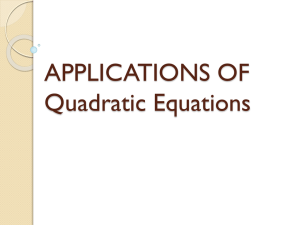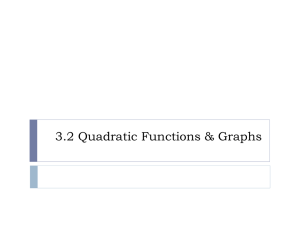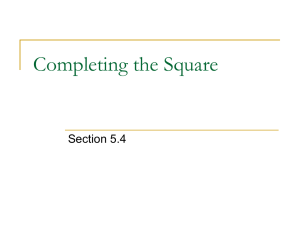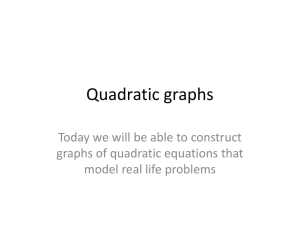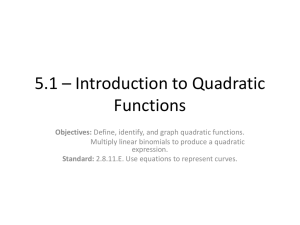doc file
advertisement
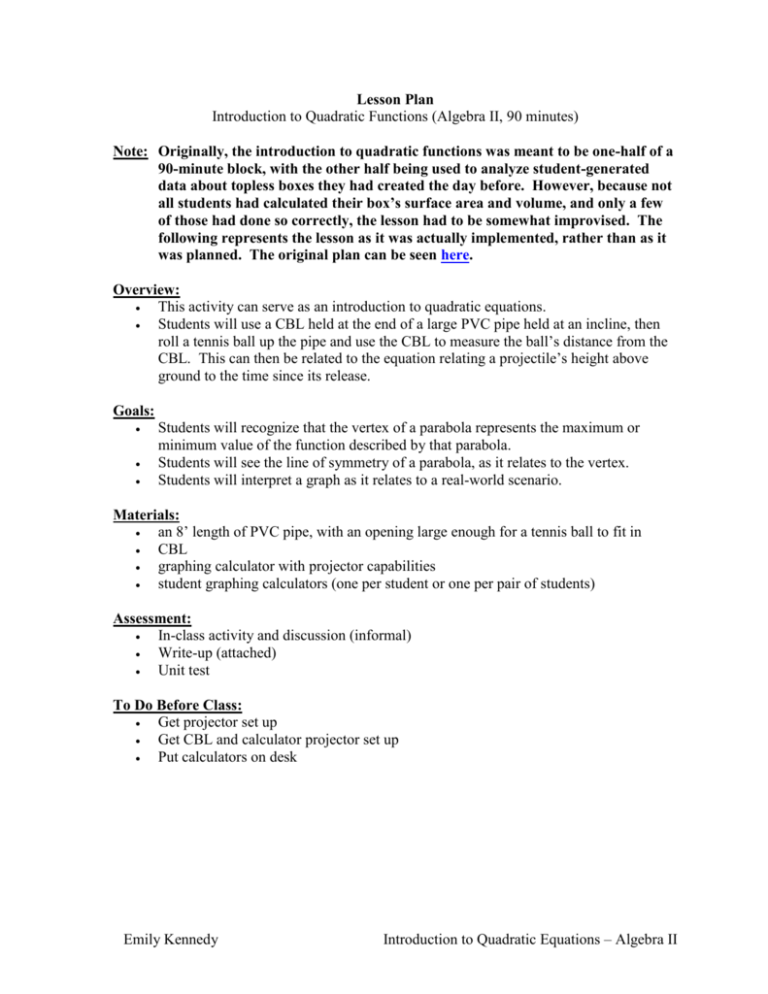
Lesson Plan Introduction to Quadratic Functions (Algebra II, 90 minutes) Note: Originally, the introduction to quadratic functions was meant to be one-half of a 90-minute block, with the other half being used to analyze student-generated data about topless boxes they had created the day before. However, because not all students had calculated their box’s surface area and volume, and only a few of those had done so correctly, the lesson had to be somewhat improvised. The following represents the lesson as it was actually implemented, rather than as it was planned. The original plan can be seen here. Overview: This activity can serve as an introduction to quadratic equations. Students will use a CBL held at the end of a large PVC pipe held at an incline, then roll a tennis ball up the pipe and use the CBL to measure the ball’s distance from the CBL. This can then be related to the equation relating a projectile’s height above ground to the time since its release. Goals: Students will recognize that the vertex of a parabola represents the maximum or minimum value of the function described by that parabola. Students will see the line of symmetry of a parabola, as it relates to the vertex. Students will interpret a graph as it relates to a real-world scenario. Materials: an 8’ length of PVC pipe, with an opening large enough for a tennis ball to fit in CBL graphing calculator with projector capabilities student graphing calculators (one per student or one per pair of students) Assessment: In-class activity and discussion (informal) Write-up (attached) Unit test To Do Before Class: Get projector set up Get CBL and calculator projector set up Put calculators on desk Emily Kennedy Introduction to Quadratic Equations – Algebra II NCTM & GPS Process Standards Addressed: Students will… Problem Solving – solve problems that arise in mathematics and other contexts. (GPS: M*P1b) Students will be using technology to reason about quadratic functions, in the context of ball rolling. Communication – organize and consolidate their mathematical thinking through communication; communicate their mathematical thinking coherently and clearly to peers, teachers, and others; analyze and evaluate the mathematical thinking and strategies of others. (GPS: M*P3a,b,c) Students will be expected to discuss their predictions, conjectures, and observations and to back up their arguments with mathematical reasoning. Connections – recognize and apply mathematics in contexts outside of mathematics. (GPS: M*P4c) Students will apply mathematical reasoning to understand the ball rolling problem. Representation – select, apply, and translate among mathematical representations to solve problems; use representations to model and interpret physical, social, and mathematical phenomena. (GPS: M*P5b,c) Students will predict the representation of the ball’s position that will be generated by the CBL, and interpret different aspects of this representation as they relate to the real-life context of projectiles. Students will also translate from the graph to an equation (y = -4.9t2 + v0t + h0) and determine what changing different parts of the equation does to the graph, and what this means in the context of ball rolling. Emily Kennedy Introduction to Quadratic Equations – Algebra II Time Begin: 9:46 Activity Box problem data Purpose / Goals Remind students how to calculate surface area and volume Ball rolling See an example of a quadratic function. Introduction to vertex and axis of symmetry. 10 min. 9:56 40 min. 11:36 40 min. Equation To understand the ball rolling situation using another representation Detail Very few students completed their homework! Tell students it will be taken up for a grade tomorrow. Because many of those who tried to do their homework had forgotten how to calculate the surface area and volume of a topless rectangular prism, have them work in class to calculate these data, and clear up misconceptions. Two volunteers hold the pipe at a slight angle (about 2.5 feet rise) While thrower practices throwing the ball up the ramp, students predict what the graph will look like (distance from CBL vs. time). Thrower throws the ball until we have a good parabola. Trace the graph on the board. Turn off the projector, and work with the graph on the board. Compare to predictions. What happened at the two sharp turns (from a horizontal line to a parabola) on the graph? What’s the second “hump”? What other special points do we see? What happened there? Vocab: We call this minimum the vertex of the parabola. The max or min always occurs at the vertex. Time from start to min? Time from min to end? (same) When was the ball 4 feet from the CBL? (TWICE). Time from first to min? Time from min to second? Generalizations? Vocab: Axis of symmetry. What is the relationship between the axis of symmetry and the vertex? y = -4.9t2 + v0t + h0 What does each of these variables mean, in the given context? How could we have rolled the ball differently to change v 0? h0? I bend down to the ground and throw the ball straight up in the air. Let’s say I throw it with an initial velocity of 3 meters per second. Students use graphing calculators to graph the equation representing this ball’s height above the ground. What special points do we see on the graph? What is the domain of the function (i.e., for what time values does the function not represent the projectile’s height)? At what time(s) is the ball on the ground? What do we call these points? (x-intercepts) What is the relationship between the vertex and the x-intercepts? (It’s halfway between them.) What if I had started on top of a tall mountain, 100 meters above a river, and I threw it upward at an angle so that it landed in the river? What would that change about the equation? Graph it! What differences do you see? What if we were on the moon? What would change then, in terms of the ball’s movement as well as how it relates to the graph and the equation? How does this change affect the graph? Emily Kennedy Caution! Reflection The graph we got: I didn’t mark the CBL’s scale before I turned off the projector! This caused some confusion later on (see below). I had to make up numbers here, because I had lost the CBL’s data. Unfortunately, this equation has to do only with the ball’s height above the ground, rather than its distance from the CBL (because the pipe was not going straight up). Justin asked an interesting question: “Can you ever throw the ball so hard that it goes out into space?” This gave me a good opportunity to remind students that this equation was only theoretical, and only approximated a projectile’s height so long as the projectile was relatively close to the earth’s surface. Introduction to Quadratic Equations – Algebra II Name _________________________ Date __________________________ Cubic and Quadratic Functions Boxes and Ball Rolling 1. Fill in the data for the box(es) you cut out yesterday: Cutout size Volume Surface Area The Box Problem – Volume (Note: We had to postpone filling out this side of the sheet until the next day because of insufficient box problem data) 2. Sketch the volume curve as it looks when we first graph it, and as it looks when we zoom out. first graph zoomed out 3. What is the volume function? V = __________________________________ What kind of function is this? ______________________________________ The Box Problem – Surface Area 4. Sketch the surface area curve as it looks when we first graph it, and as it looks when we zoom out. first graph zoomed out 5. What is the surface area function? S = ______________________________ What kind of function is this? __________________ What shape is the graph? _________________ 6. Max surface area: __________________ Cutout size to get this surface area: __________________ 7. Name two differences between cubic and quadratic functions (their equations, their graphs, etc.) Ball Rolling (Note: This part of the sheet is what we did on this day) 8. Predict the graph that will result from graphing “distance from the monitor” on the y-axis and “time” on the x-axis. It’s okay if it turns out to be wrong! 9. Sketch the actual graph that resulted. 10. On the graph in #9, label the parabola’s vertex and axis of symmetry. 11. What happens at the vertex of any parabola? What does the axis of symmetry of a parabola have to do with its vertex?
